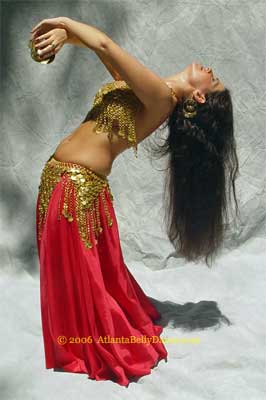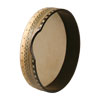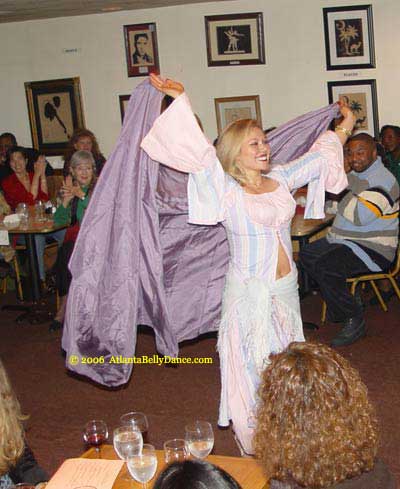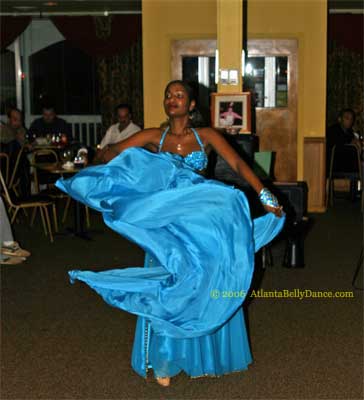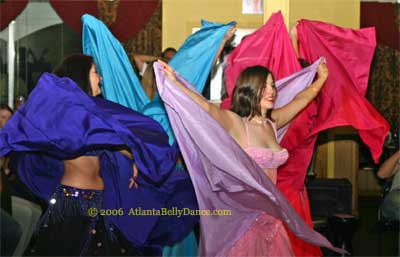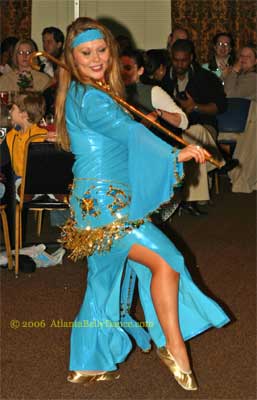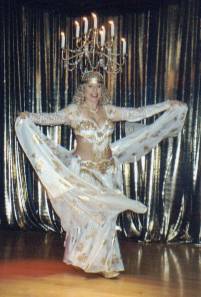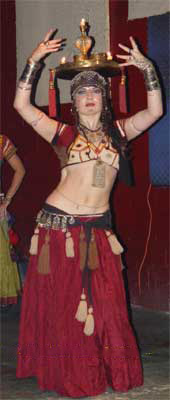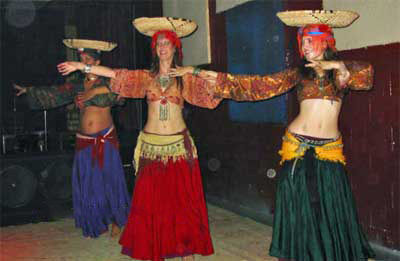
|

|
|||||||||||||||
Drum (Solo) DumbeksThe Dumbek drum is played in North Africa - from Morocco to to Egypt, throughout the Arabian Peninsula, and from Greece to Persia. They come in a variety of materials from ceramic, nickel-plated brass, aluminum, and wood. They are skinned with goat skin, calf skin, and fish skin.While not a prop per se, as it is hard to dance while playing the drum, dances like the drum solo could not take place without a drummer, so we feel like we should include it in this list.
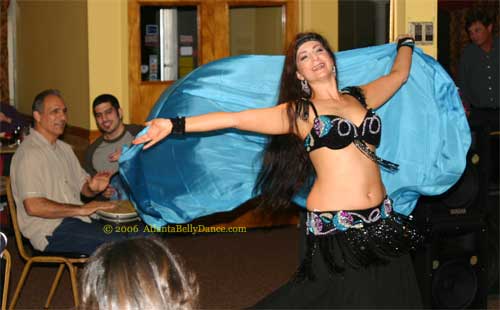
Spoons(Excerpt from spoondance.secession. at/e_learning/index_e.html)The dance was/is danced in various regions of Greece, but mainly originates from Cappadocia [Southern Central Turkey], here from the regions around Farassa, Silli, and Ikonio. There is a wide breadth of variety of the dance: how and when it is danced and who dances it. In the spoon dance, each dancer dances with a pair of wooden spoons in each hand, in that they clap out a rhythm supplemental to the music, while the feet dance a different step rhythm (which is very confusing at first for those learning the spoon dance). Since the melody in the foreground does not repeat the rhythmic motif clapped by the spoons, the dancers are, so to speak, musicians, who, in the background, clarify the music being played. The dancers dance freely in the room in pairs comprised of the opposite or the same sex. The couples relate to one another and together they make various turns to the music. 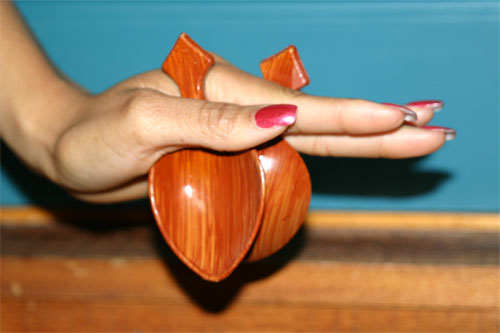 Turkish dance spoons In some cases it is danced only by women, which is usually the case, or by men (whereby in these particular regions it was considered immoral for women to dance with spoons), or in other cases both men and women danced together, sometimes even married couples. It was danced on different occasions: engagements, weddings, carnivals, and religious festivals. Spoons were widespread as instruments in Cappadocia, and often dances were accompanied only by song and spoon rhythms.
Veil(www.shira. net/styles2.htm)Some americans make their entrance with the veil tucked into their costume.Veil wraps vary according to the dancer's individual taste, but many dancers wrap their veils in a way that completely covers the torso, and often the bottom edges of the veil also hide the belt. That way, when the dancer eventually removes her veil, the costume underneath is a bit of a surprise for the audience. It effectively gives two different costume variations in a single dance. At the very beginning of the dance, the dancer (still fully veiled) might do some soft, graceful movements with her arms, hip sways, undulations, etc. She then transitions from those to removing one side of the veil, often while spinning and using her eyes and movement of her free hand to direct attention away from the hand that's peeling off the veil. She might dance with half the veil thus free and half the veil still tucked in, or she might then proceed to remove the other side--whatever inspires her at the moment.
For the duration of the slow number, she uses the veil as a primary element of her dance. It might be a frame for a beautiful undulation. It might flow freely as she spins. She might wrap it around her body, then undulate fully wrapped, then unwrap it while dancing. Many American dancers have come up with beautiful innovations on what to do with the veil. As the rhumba draws to a close, the dancer gracefully discards the veil--sometimes by wrapping it around the head of a male audience member like a turban, sometimes just dropping it where it will be out of the way. This veil work generally lasts about 3 minutes altogether, and usually (but not always) the dancer uses the veil the full time, not discarding it until that song ends.
Scarf/Handkerchief(www.shira. net/styles2.htm)
Used for the Dahiya - the Egyptian Scarf Dance Of course, exceptions have existed. In particular, Samia Gamal, did some beautiful, swirling veil dances. However, such dancers are definitely the minority in Egypt. There is a type of character dance done by Egypt's folk troupes known as melaya lef which uses a shawl-type of garment known as a melaya as a prop. In the melaya lef folkloric dance, the dancer plays the role of a mischievous young woman who flirtatiously plays a "conceal and reveal" game with her wrap. In Egypt, an Oriental dancer might use the melaya lef dance for the folkloric part of her show, but she doesn't do so wearing her Oriental costume. In the U.S., since most Americans doing Egyptian style dances don't have the opportunity to do a costume change after the Oriental set and come back out in folkloric costume, they rarely use the melaya lef in their Oriental performances. 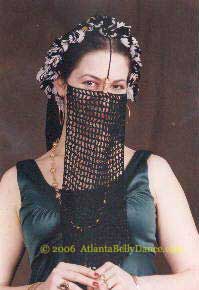
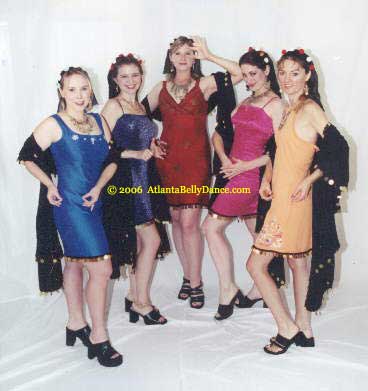
Candle dancewww.pinkgypsy. com/questions3.htm:Serena was known as the dancer with candles. Years ago I [Zahraa] thought she picked up the dance in the Greek night clubs she performed in. Yet, recently I asked Rip (her husband) how Serena came to dance with candles. He told me that when they were young they saw a Filipino dancer perform with candles in his hands and balance them on his feet. Rip said to Serena "why don't you try that?" Hence, she became famous for her beautiful candle dance where she would flutter them on her belly. Moreover, I [Zahraa] am a Greek folk dancer (and belly dancer) and know that candle dancing is native to Metalini Greece (bordering on Asia Minor--Turkey). This dance is a traditional folk dance performed with candles in ones hands to a Sirto rhythm. The name of the dance means "fire" in Greek. Steps are simple consisting of a step-back crossing step in a triplet pattern. Moreover, the dancer will turn with this step. Candles are held and spiraled in a circular manner. Also they are brought into the dancer's chest and out to the audience. Sometimes the dancer twists the candles in a figure eight over the head and down to the body (in the same way American belly dancers do!!). We at Nazeem Allayl use candles as props for our Pharonic Dance.
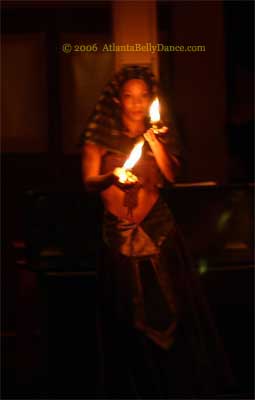
SnakeWe refuse to promote the dancing with snakes.Props for Balancing:Sword(Source: www.calacademy. org/research/anthropology/tap/ARCHIVE/2003/2003-04--bellydancing.html)Sword dancing, or Raks al sayf, was not a widespread dance style in the Middle East. Men in Egypt performed a dance called el ard, a martial arts dance involving upraised swords, but women were not widely known to use swords as props during their dancing. Here in America and in other western countries, sword dancing is much more common and—due to its dramatic nature—very captivating. Dancing with a sword illustrates the strength and power of a woman, as well as her poise and balance.
www.pinkgypsy. com/questions3.htm: Note: Belly dance swords must be specially balanced and are usually dull to protect the audience. 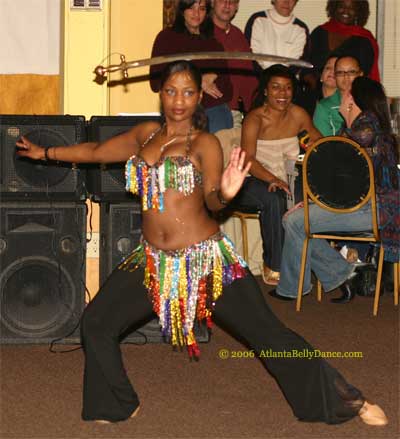
Candelabra(Source: www.sakti-international. com/candelabra.html):
The Zeffah al-arusah is the bridal procession, and in Egypt the shamadan plays an important role. It is a tradition that at least one shamadan crowned dancer leads the bridal party. The Zeffah today often takes place in a hotel in the banquet hall or at the military clubs in their private banquet room. I was fortunate to perform for many of these wedding parties in hotels as well as the officers clubs. I also received a medal from the Egyptian Officer Club in 1993 to show their thanks and appreciation for my art. In former times it was an outdoor processional that accompanied the bride to her new home. The shamadan bearing dancer lit the way through the dark street in the days before electricity, and the candle served as an announcement that a wedding had taken place. Basket and Water Jug
|

